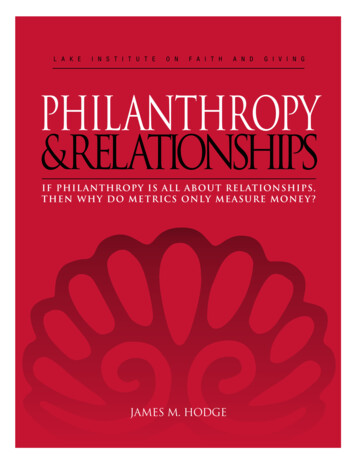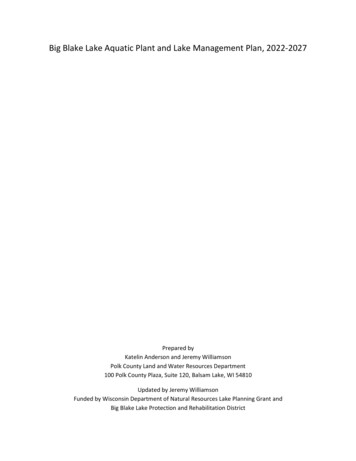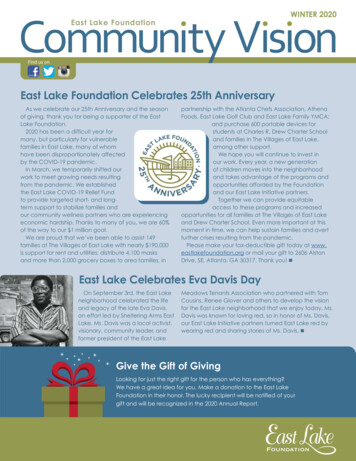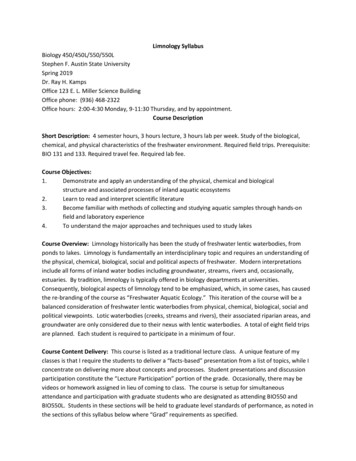
Transcription
L a k eI n s t i t u t eo nF a i t ha n dG i v i n gPHILANTHROPY&RELATIONSHIPSIf Phil anthropy Is All About Rel ationships,Then Why Do Metrics Only Measure Mone y?JAMES M. HODGE
PHILANTHROPY & RELATIONSHIPSIf Philanthropy Is All About Relationships,Then Why Do Metrics Only Measure Money?The Material to Spiritual Transformation of PhilanthropyJames M. HodgeMayo ClinicThe Center on Philanthropy at Indiana UniversityIndiana University-Purdue University Indianapolis
2012 by James M. HodgeExcerpts of more than 100 words from this publication maynot be reproduced without permission. Editorial questionsand permission inquiries may be addressed to:Publications DepartmentThe Center on Philanthropy at Indiana University550 W. North St., Suite 301Indianapolis, IN 46202-3272Telephone: 317-274-4200Web site: www.philanthropy.iupui.eduDesign and layout by Beyond Words, Inc.
For EwOrdThe Center on Philanthropy is dedicated to advancing the common good, understandingthe powerful role that philanthropy can play in improving the world. On March 22,2012, the Lake Institute on Faith & Giving, a keystone program of the Center onPhilanthropy at Indiana University, hosted the ninth Thomas H. Lake Lecture. Thisannual lecture has historically served as a catalyst for positive change in our society,casting a positive impact on the broad field of philanthropy. Our extensive experienceand expertise, our grounding in research and our commitment to marrying practicalskills with a theoretical understanding of philanthropy is showcased through theannual Lake Lecture series.Each year we are pleased to host an original presentation by a recognizedscholar interested in the intersections of faith and giving. We intentionally elevate ideasthat foster engaging discussion and yield practical insights for a diverse constituencyof participants. Past speakers have covered a wide range of topics that include the roleof charity in religious identity and have explored key topics examined through thedistinct lens of research across three major faith traditions––Christianity, Judaism andIslam. Lecture respondents represent the various cross-sections of our community asthey offer their responses to and understanding of the lecture topic selected each year.Together the Lake Lecturer, the respondents and the audience have made the LakeLecture an anticipated community event.This year, we had the pleasure of hosting James M. Hodge III, AssociateDepartment Chairman and Director of Mayo Clinic’s Principal Gifts Program, facultymember of The Fund Raising School at the Center on Philanthropy and past VicePresident of Development at Bowling Green State University. He addressed the topic“If Philanthropy is all about relationships, then why do metrics only measure money?”with wisdom and deep reflection. A national voice on values-based philanthropy, Jimspeaks frequently on the importance of transforming philanthropy, relationships andmetrics. An accomplished speaker and author, Hodge also wrote the chapter entitled“Gifts of Significance” in the seminal guide for fundraising Achieving Excellence inFund Raising edited by Jossey-Bass.Co-founder of a multi-million-dollar for-profit business within Mayo Clinicthat provides a 24/7 nursing and medical advice service worldwide, Jim Hodgechallenges the world of philanthropy to shift from material to spiritual transformationin both approach and measurement. He cautions “when our focus is primarilyon money in seeking philanthropy, we chase money rather than meaning in ourprofession.” He notes that the focus on the product (money) lessens the importanceof purpose in our work, and it not only raises less philanthropy, it devalues the noble
role that philanthropy can play in a well-examined life. Such reflection encourages anidealized, new and engaged philanthropy that results from nonprofit organizationsand philanthropists working together to create a future where shared interests are bothvalued and pursued.The Thomas H. Lake Lecture, a program of the Lake Institute, is the legacy giftof Tom and Marjorie Lake, their daughter Karen Lake Buttrey and Lilly EndowmentInc. We honor the philanthropic values of the Lake family through strategic prioritiesthat continually examine how faith inspires and informs giving. Through years ofintentional community building, we have nurtured an environment for public inquiryand crafted hands-on training that assists faith communities and donors in the pursuitof their philanthropic passions. The Lake Institute exists to explore the relationshipbetween faith and giving in various religious traditions. We celebrate the Lake Lectureas an extension of this philanthropic passion.Patrick RooneyExecutive DirectorThe Center on Philanthropyat Indiana UniversityMarch 2012
Philanthropy & RelationshipsIf Philanthropy Is All About Relationships,Then Why Do Metrics Only Measure Money?The material to spiritual transformation of philanthropyIf it is a truism that “what we focus upon we become,” then perhaps we need botha vastly wider aperture as well as a more relevantly focused system of metrics forphilanthropy. If we only focus on money, we will not only raise less money, but alsowe will devalue the noble role that philanthropy can play in well-examined lives.When our work is primarily directed toward raising money, we chase moneyrather than meaning in philanthropy. We become less aspirational for our institutionsand less inspirational to our benefactors.There is another way. I contend there is a higher path for our work and thatthe creation of a relationship-based system of mentoring, coaching, and leading thephilanthropic process will result in philanthropy well beyond our present levels, andindeed beyond our highest hopes. A focus on shared value systems, on the good thatcan come from combining visionary nonprofits and committed philanthropists, willpropel philanthropy to new levels, resulting in a greatly expanded third sector inour economy.Philanthropy is more about openings rather than about closings. It is aboutmutual aspirations of what is important and valuable to society. Gifts of significanceare not so much about money as they are about meaning. We have much to learnfrom America’s most successful entrepreneurs in this regard. The truly successful,hypo-manic serial entrepreneurs all sing the same melody about their energetic and
euphoric foci on their work. It rarely involves the word money. From Edisons toDisneys to the unsung successful entrepreneurs in each of our communities, thesame motivational mantra is spoken: It is not about money. It is, however, aboutinventing, about a contagious idea, about entering a market first, about building anelegant widget, about changing peoples’ mindsets. Money is just a way of keepingscore. Edison perhaps said it best when he exclaimed, “After I have completed aninvention,” remarked Edison, upon another occasion, “I seem to lose interest init. One might think that the money value of an invention constitutes its reward tothe man who loves his work. But, speaking for myself, I can honestly say this is notso. Life was never more full of joy to me, than when, a poor boy, I began to thinkout improvements in telegraphy, and to experiment with the cheapest and crudestappliances. But now that I have all the appliances I need, and am my own master, Icontinue to find my greatest pleasure, and so my reward, in the work that precedeswhat the world calls success.”1 Purportedly, when asked why he continued toinvent since he was so rich, Edison remarked that people didn’t understand hismotivations. He didn’t invent to make money; money allowed him to pursue hispassion of inventing.If we accept this as true, then our pursuit of money will never inspire giftsof significance.Indeed, such a pursuit creates a sense within potential benefactors of beingconsidered merely for their financial resources and not the plethora of talents andabilities benefactors can bring to an inspiring nonprofit organization. It is aboutthe difference philanthropy can make in lives and communities and the world, andnever about money. Most entrepreneurs I have come to know well and happily,as Bank of America and the Center on Philanthropy studies have shown, aresignificantly more philanthropic than others who are salaried or make their moneyin non-entrepreneurial ventures2. They describe their passions more like MihalyCsikszentmihalyi’s famous psychological studies and writings on Flow. When thesecontagious souls are in “flow” in their work endeavors, entrepreneurs describeMarden, Orison Swett. How They Succeeded: Life Stories of Successful Men and Women Told byThemselves. Boston: Lothrop Publishing, 1901.2The Center on Philanthropy at Indiana University. The 2010 Study of High Net Worth Philanthropy.Indianapolis: Bank of America Merrill Lynch, 2010.12
their mental state as ferociously focused, single-mindedly immersed in a world ofnew ideas or better processes or novel markets. These are the souls swimming inMarborgne and Kim’s Blue Oceans and dancing in Chris Anderson’s Long Tails asdescribed in these popular business books. Money never comes to mind except asthe fuel that enables them to accomplish their visions. Thomas Edison once said, hisgoal was to make light bulbs so inexpensive that only the rich could afford to burncandles. So if these great visionaries in business, and now we recognize great exemplarsin philanthropy, see money only as a fuel for joy and passion, then why should wefellow travelers in philanthropy not adopt a similar stance toward our work?Money applied to philanthropic ends is a medium to serve others, to dopurposeful work, to empower people to help themselves, to make an impact, and toimprove the lots of others and the very health of our planet. Our philanthropic focus,therefore, must be on ideas and ideals and the power that they can have not only onthe improved lives of those served but also on the quality of lives of philanthropistsand those who work in the nonprofit world. For as Bob Payton once powerfullyinquired, “Do we live for philanthropy, or do we live off of philanthropy?”3 Do wehave an occupation in philanthropy or do you pursue a passion for philanthropy?”We indeed become that which we direct our attention to in life. Let us change thepicture and start focusing far more attention on relationships with philanthropistsand those with a philanthropic nature, rather than merely on money: on qualitativerather than quantitative metrics. Let us bring the relationship aspect of ourprofession to the foreground rather than assuming it is always the backdrop ofour work.But how do we take idealism into action through philanthropy? How dowe explore the “moral dimensions of philanthropy,”4 as Paul Schervish contendsis the true purpose aspect of our work? Seen as a spiritual exercise, philanthropistscreate their own moral biographies, according to Schervish. But are professionalsin philanthropy trained to be “moral biographers,” asking crucial questions andPayton, Robert L. “Philanthropy as a Vocation.” Philanthropy: Voluntary Action for the Public Good.New York: American Council on Education, 1988. Made available online by PaytonPapers.org.4Schervish, Paul G. “The Sense and Sensibility of Philanthropy as a Moral Citizenship of care.” GoodIntentions: Moral Obstacles and Opportunities, ed. David H. Smith. Bloomington: Indiana UniversityPress, 2005.33
entering into dialogues that significantly shift philanthropic conversations frommoney to meaning? Schervish has observed that “most wealth holders will benefitfrom engaging in what I call extended archaeological conversations with trustedadvisors, including development officers.”5 Attending to benefactors’ needs to createmoral biographies requires building genuine relationships based on trust. This is thegenesis of relationship-based metrics.Such metrics do not replace setting financial targets for our work, but theybring out the “better angels of our natures,”6 as Lincoln once said, and alter thefocus of our work. The currency of our profession is in the enduring good we dotogether with benefactors, not in the amount of money we raise from benefactors.By altering our stance toward benefactors, we avoid potential philanthropiststhinking, “Do you love me, or do you love my money?” A more powerful reflectionmight be, “Think of the walk we can take together to make lives and communitiesbetter.” When we focus on ever-deepening relationships as outcomes, we open ourapertures, we changes lives and find better ways to “dilute the misery of the world,”7as Karl Menninger suggested was the purpose of life.When we only set financial goals, we miss the power that moral questionsrespectfully, purposefully directed, can mean in the lives of benefactors. We live onlyin a financial exchange relationship until we can redirect our work on toward thetransformative effects that benefactors can have on individuals and communities. AsCarl Jung said, “The least of things with a meaning is worth more in life than thegreatest of things without it.”8 This is the money-to-meaning transformational powerof philanthropy. To discover this meaning, our work must be benefactor-centric,values-based, and inquiry-driven. Our principal task then becomes identifyingcore values of individuals who may have a philanthropic nature, conversing aboutwhat brings purpose and joy to their lives, and examining their views of the socialSchervish, Paul G. “The Moral Biography of Wealth: Philosophical Reflections on the Foundation ofPhilanthropy.” Nonprofit and Voluntary Sector Quarterly 35.3 (2006): 488.6Lincoln, Abraham. “First Inaugural Address.” 4 March 1861.7“Biography: Karl Menninger, MD.” International Child and Youth Care Network. November 2007.Web. 18 July 2012. cyc-net.org .8Jung, Carl. Modern Man in Search of a Soul. Harcourt Harvest; Fifth or Later Edition edition, 1955.54
responsibilities of wealth. These mindful conversations allow benefactors toconsider the meaning of their lives, the difference they can and should make in theircommunities and the world, and ultimately the legacy they will leave behind. It is along, purposeful walk we take with benefactors inquiring about meaning-buildingthrough philanthropy and a contemplative view of their lives’ real purpose.One of the most frequent, constantly asked questions I get from the inquiriesof young professionals in philanthropy is, “How can I tell if a potential benefactorhas a philanthropic nature?” This is a very important question that is rarelyaddressed at conferences or in institutional continuing education programs. Whenwe practice benefactor-centric philanthropy, we discover an individual’s core values,motivational makeup, and personal strivings. This is never accomplished by askingthem for money, but rather by asking them questions of significance about their lives,their aspirations, and their hopes for the future.How to discern a philanthropic nature will be an important skill set to teachprofessionals in our field. People who are evaluating their lives based upon their corevalues will not settle for less from professionals in philanthropy. Benefactors expectthat we recognize, respect, and reinforce their deepest values played out throughtheir gifts. As John Gardner observed, “If you have some respect for people as theyare, you can be more effective in helping them become better than they are.”9Exploring core values requires the highest professional ethics and a stancetoward benefactors that mirrors what Martin Buber, the great Jewish philosopher,called “I-thou,” the authentic existence, rather than “I-it” relationships. “I-it”relationships objectify people, making them tools for our own benefit. We see themas a source of money rather than being in relationships with them and exploringthe potential of doing good together in the world. An “I-thou” relationship withbenefactors necessitates seeing individuals as ends in and of themselves (theirvalues and their partnership) rather than seeing them as a means to an end (theirmoney). Buber’s work contends that “human lives find meaning in that “I-thou”relationship.”10 Viktor Frankl perhaps expressed it in another way when he said,Gardner, John W. Proverbia. Web. 2 September 2011. En.Proverbia.net .Scott, Sarah. “Martin Buber (1878-1965).” Internet Encyclopedia of Philosophy. The New School ofSocial Research, 2010. Web. 18 July 2012. iep.utm.edu .9105
“It is not so much a matter of technique that is important but the spirit behind thetechnique that matters.”11 The spirit of our work in philanthropy requires beingin genuine relationships with fellow travelers who have the potential to improvethe world. This is the material-to-spiritual shift in our work, and when practiced,the reward is working with more engaged philanthropists and far more joy andfulfillment throughout our careers.Tom Morris repeatedly expressed this important shift in ethical stancetoward people and the remarkable results that ensue when he said, “It is byimagination that we cross over the differences between ourselves and other beingsand thus learn compassion, forbearance, mercy, forgiveness, sympathy, and love—the virtues without which neither we nor the world can survive.”12When we have established an I-thou relationship with benefactors, our workbecomes infused with powerful stories of our organization and benefactors at theirits best, stories that illustrate our institutional impact on those whom we serve andcelebrate powerful exemplars in philanthropy. We inquire of benefactors: “Whatare your passions? What drives you to achieve? When do you feel you are at yourauthentic best for yourself and for others? What can you do with your resources thatwould bring meaning to your life?”Over time we discover if an individual’s passions about their vocations oravocations can be grafted to your organizational mission. In truly transformativephilanthropy, these passions grafted to your organization can evolve into full-blownpassion transplants where benefactors adopt your organizational mission as the mostmeaningful work of their lives.As Tom Morris further observed, “People are inspired over the long haulby a sense of nobility in who they are and what they are doing. If you can convey asense of nobility to people around you, you can unlock their deepest potential.”13Expressed similarly by William Irvine in his book On Desire, “Every man,however hopeless his pretentions may appear to all but himself, has some projects by1112136Frankl, Viktor E. Man’s Search For Meaning. Boston: Beacon Press, 1959.Morris, Tom. If Aristotle Ran General Motors. New York: Henry Holt and Company, Inc., 1997. 167.Morris, 214.
which he hopes to rise to reputation; some art by which he imagines that the natureof the world will be attractive.”14 About a famous Minnesotan, Charles Lindberg,F. Scott Fitzgerald said, “Something bright and alien flashed across the sky, a youngMinnesotan who seemed to have nothing to do with his generation did a heroic thingand for a moment people set down their glasses in country clubs and speakeasies andthought of their old best dreams.”15It is meaning we seek, and it is meaning we must address in philanthropicdialogues. Once the spirit behind their work is engrained in professionals, wemust equip them with skills to tell important stories, to engage in illustratingour organizations’ missions in powerful metaphors. To finish the sentence whichbegins, “Isn’t it amazing . . .” with examples of the good our organizations haveaccomplished. To complete another sentence, “Can you imagine . . .” with examplesof how together an effective nonprofit and an inspired benefactor can change a life,a community, and indeed, the world.When in an “I-thou” relationship with benefactors, the use of appreciativeinquiry becomes a natural extension of our philosophy. Instead of talking about the“needs of nonprofits” or the challenges and problems that face one’s organization, ashift in the nature of the questions we use is essential. Nonprofit institutions whichspeak consistently and insistently of their “needs” become, in fact, “needy” anduninspiring. Instead, specific training in appreciative inquiry developed by DavidCooperrider and followers, talks of individuals’ and institutions’ highest hopes andaspirations. Lynn Twist, author of The Soul of Money, expressed it well when sheobserved, “If we can, we must shift our frame of reference from one of ‘problemsolving’ to one that seeks to identify the resources available in any collection ofpeople who are inspiring, mobilizing, and sustaining positive change. What youappreciate, the way you direct your attention determines the quality of your life.”16Appreciative inquiry is all about co-creating an idealized future for ourselvesand for our communities. What Kind of World Do You Want? is not only the titleIrvine, William B. On Desire: Why We Want What We Want. New York: Oxford University Press, 2006. 34.Fitzgerald, F. Scott. “Echoes of the Jazz Age.” The Crack-UP. New York: New Directions PublishingCorporation, 1945. 20.16Twist, Lynne. The Soul of Money. New York: W.W. Norton & Company, 2003. 132.14157
of a wonderful book by Jim Lord and Pam McAllister but also the essential questionbehind all appreciative philanthropy. Can you envision our world at its best? Isachieving these aspirations not a noble and spiritual purpose for our lives?Through observation and inquiry, we examine whether individuals have apropensity toward accumulating in their lives. If they have a high material valueorientation, a habit of buying things rather than a more spiritual orientation ofcreating meaning, we can discern their philanthropic nature, or lack thereof.Newcomers to our profession should be taught, coached, and mentored instorytelling techniques and in questioning skills that can unlock philanthropic natureand maximize philanthropic potential. Self-assessment instruments can be createdto determine whether development officers are enhancing relationship equity withpotential benefactors as well as the relationship quotients between benefactorsand institutions and their missions. Lickert Scale (LS) questions can be employedto determine donor attitude as we assess the evolving relationships betweendevelopment officers and benefactors. With this system we can further assess howdevelopment officers are shaping important relationships between benefactors andtheir institutions.Questions can be taught and observational skills developed to determinewhether individuals are primarily ego-centric and self-absorbed, or other-centric andgenerative. Understanding and teaching Eric Erikson’s stages of adult developmentcan help in the assessment of individuals inclined toward hoarding from those whoare philanthropic and inclined to sharing. Are potential philanthropic partnersaccumulators, amassing fortunes like Monopoly properties with a winner-take-allmentality? Or are they more like some other souls described in the book Driven, whohave a strong propensity toward caring and sharing?Master key questions that center on an individual’s spirituality, intellectualcuriosity, decision making, learning, and societal styles can be articulated and taught.How to earn trust, to respectfully ask ever–deepening questions concerning corevalues can be modeled and practiced. Appreciative inquiry workshops abound, andFranklin Covey classes on trust building can be explored.It is true that highly skilled and experienced professionals in philanthropy8
have developed and honed their relationship-building skills. They have anarmamentarium of thoughtful questions to ask benefactors, and are skillful atknowing when sufficient trust is established with benefactors to ask significantand deeply personal questions. But veterans and newcomers alike should have astructured system of examining what they know and what they do not know aboutindividuals with whom they work. Simple Lickert Scale questions can be developedthat help monitor and chart the relationship metrics of our encounters, engagements,and experiences with benefactors. Such a series of weighted questions can determinehow skilled a development officer is at creating and strengthening relationshipswith benefactors.Two master key questions of importance are as follows: First, what is myrelationship equity with this benefactor? How do I resonate with this benefactor andwhat is our level of mutual trust?012345New/Weak Mature/StrongSecond, what is the institutional relationship quotient with this benefactor?Am I strengthening the ties between this potential benefactor and our organization,our leaders and our mission?0123Little/Weak45Substantial/StrongBy asking what we know and what we have yet to discern about a potentialbenefactor, we begin to see what respectful questions and crucial conversationswe need to have to better understand what project might resonate with thisperson philanthropically. Is it an inspiring initiative that can bring meaning to thebenefactor’s life? Is it the right time, the right scale, and the right project for thisindividual? Is it a project that can grow and develop further, and one that will engagethe benefactor over his or her lifetime?9
All individuals go through ages and stages of adult development, sobeautifully articulated by Erik and Joan Erikson. The Eriksons contend that laterin one’s adult life as they age, they can either ripen or spoil, either reach integrity,and generativity and be self-actualized or become more and more self-absorbed andstagnant. By observing benefactors’ actions over a period of years and by probingvalues, one can be sensitive about emotional events occurring in a benefactor’s life.What triggers and shifts are occurring in their lives that are emotional momentsappropriate for favorable philanthropic dialogues or moments graciously to givebenefactors space and time to deal with the trials and tribulations of life. Schervishagain encourages us by saying that when “a process of discernment is carried outwith no hidden agendas and with the purpose of helping wealth holders uncovertheir true aspirations, a deeper commitment to philanthropy ensues.”17 Assessing abenefactor’s significant emotional events and key indicators of shifts in thinking isessential when exploring gifts of significance. Do benefactors easily discuss deathand dying, estate planning, and ultimate legacies? How do they define as a familywhen “enough is enough” and what they perceive as the social responsibility oftheir wealth?These are not new concepts but a deliberate system of relationship-basedevaluations which enable managers to determine if development officers are trulyaffecting the lives of benefactors and if they have the skills to engage others inquestions of significance. Our work requires a purposeful shift to authentic, everdeepening relationships and not solely requests for money and dollar-based metrics.What might make up a philanthropic nature, a potential to be generous? Whatroles do compassion, empathy, and gratitude play in the philanthropic personality?How might we deliberately assess these characteristics through stories, parables,metaphors, and questions?Discussing recent disasters that afflict the world might reveal levels ofempathy and compassion in potential benefactors. Determining if a person’s empathyis based on feelings—“This is tragic and we feel compelled to help”—or whether1710Schervish, 489.
empathy is more of a learned feeling, more grounded in learned behaviors as in “Ourparents always taught us, ‘To whom much is given, much is required,’” and it is theobligation of wealth to be generative and to help others. Knowing the predominantform of empathic response may shape how we engage potential benefactors inexperiences that are mission impactful.Gilmore and Pine, in the book Authenticity, teach us that, “Todayparticipating in meaningful experiences represents the largest unmet needs ofAmericans, more precious than economic capital: religion, country, art, and familyand education, these are the resources that are literally priceless, from which wedraw distinctions regarding our purposes in life.”18An outline of the philosophy behind appreciative philanthropy and apotential outline for teaching relationship-based metrics are illustrated in Table I.A system of relationship-based metrics would also be important to the continuedenergy and passion of development officers. Rather than a practice or orientation of“scheming for money,” development officers would both dream of and aspire to aworld of possibilities with benefactors. Through an appreciative-inquiry approach,both benefactors and development officers generate energy between them, resultingin better co-created futures for our organizations and the people whom we serve.Burnout would be reduced, job hopping would lessen, and the nobility of our workwould be palpable and efficacious. In such a system we would become more likemoral trainers, as Michael O’Neil once described our work in philanthropy, or“agents of change,” as Sheldon Garber viewed our profession at its best.If we raise our sights and refocus our energies, we will find remarkableresults that are impactful and patently obvious to philanthropists. They will fundnew models of doing our work and efforts to assess the replicability and scalabilityof those models. They will, as the newly engaged philanthropists demonstrate, bringall of their resources to bear on solving significant societal issues. Those resourceswill include their business acumen, talents in raising capital, insights and experiencesin the marketplace, financial resources, and more importantly, their commitment.Gilmore, James H, and B. Joseph II Pine. Authenticity: What consumers Really Want. Boston: HarvardBusiness School Press, 2007. 76.1811
They will be compelled to join us in improving people and the planet. They willknow when to apply capital and when a project should be h
that provides a 24/7 nursing and medical advice service worldwide, Jim Hodge . Edison perhaps said it best when he exclaimed, "After I have completed an invention," remarked Edison, upon another occasion, "I seem to lose interest in it. One might think that the money value of an invention constitutes its reward to . Thomas Edison once .











